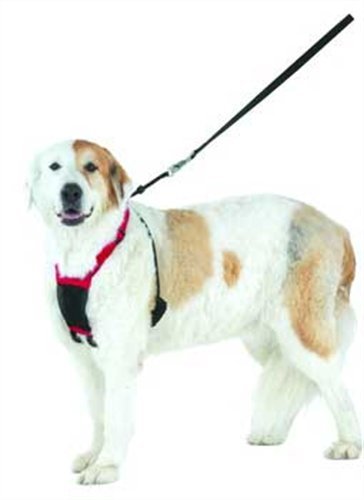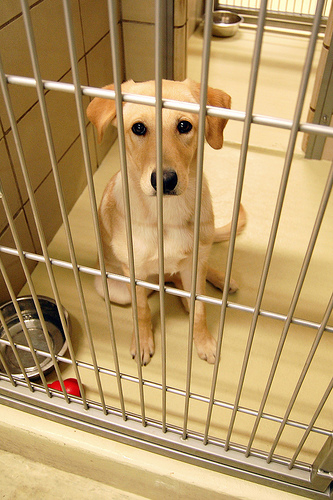

I am the proud owner of a little man named Wyatt who was born on February 12, 2009. He is a first-generation Havachon (Havanese/Bichon mix) and has grown to about 15 lbs. I rescued him on Easter Sunday 2009 from the flea market. I sometimes refer to him as my flea market puppy. Wyatt has been a wonderful and constant companion and friend these past five years.
Wyatt is an exceptionally smart, well-behaved and happy dog. He was one of the most agile dogs that I have ever known. He could stand on his hind legs and spin around for minutes (like a circus dog) or catch items with his front paws while standing on his hind legs, jump on and leap off of furniture in a single bound, and run extremely fast as if he were in a race to the finish. His aerial feats were amazing. I remember seeing those agility contests for dogs on TV and thought of signing him up for agility classes so that he could one day compete. Unfortunately, life threw us a little curve.
One evening in late September, 2012, I noticed that Wyatt was not acting his usual,
 playful self. He was hesitant to run, jump, go up the stairs, and at one point, stood shaking as if he were having a seizure. The symptoms he expressed lasted about 15 minutes and then he was his young self again. Even though Wyatt seemed fine the next morning, I took precaution and took him to the vet. The vet performed blood work on Wyatt, examined him and concluded that Wyatt may have injured his spinal cord. The vet suggested that I take Wyatt for x-rays which I opted not to do. Instead, Wyatt was given a steroid shot to cut the swelling of the spinal cord and prescribed pain medication. After a few days confined in a crate, Wyatt soon returned to his active lifestyle.
playful self. He was hesitant to run, jump, go up the stairs, and at one point, stood shaking as if he were having a seizure. The symptoms he expressed lasted about 15 minutes and then he was his young self again. Even though Wyatt seemed fine the next morning, I took precaution and took him to the vet. The vet performed blood work on Wyatt, examined him and concluded that Wyatt may have injured his spinal cord. The vet suggested that I take Wyatt for x-rays which I opted not to do. Instead, Wyatt was given a steroid shot to cut the swelling of the spinal cord and prescribed pain medication. After a few days confined in a crate, Wyatt soon returned to his active lifestyle.
On March 26, 2013, I was getting ready to leave for work when I called Wyatt over to me to say goodbye. Instead of running on all four legs, he walked only on his front legs, dragging his hind legs. His paralysis came as a surprise to me as he had been his usual active self earlier in the morning. I called off work and off to the vet we went.

Vet Specialist: I drove the one hour to the specialist’s facility which included an animal hospital. After examination and a CT (computed tomography) scan[1] to find the source of the injury, the specialist diagnosed Wyatt with Intervertebral Disc Disease (IVDD).
IVDD is “a condition where the cushioning discs between the vertebrae of the spinal column either bulge or burst (herniate) into the spinal cord space. These discs then press on the nerves running through the spinal cord causing pain, nerve damage and even paralysis.” and is “common in the neck region of smaller breeds, discs develop a hardening (or calcification) of the outer layer. This damages the disc, allowing it to break down easier. Any forceful impact such as jumping and landing can cause one or more disc(s) to burst and the inner material to press on the spinal cord. When the nerves of the spinal cord are compressed, the nerve impulses are not able to transmit their signals to the final destination in the limbs, bladder, etc. If the damage is severe enough, paralysis and loss of bladder and bowel control can occur. Depending on the location of the disc that is bulging, signs occur anywhere in the body from the neck to the rear legs.”[2]
 Wyatt had two herniated discs. The specialist advised a laminectomy needed to be performed. A "Laminectomy refers to a surgical procedure in which a portion of the bone of a spinal vertebra is removed to allow access to the spinal canal and/or achieve decompression of the spinal cord."[3] Again, the specialist reiterated that Wyatt needed to immediately have surgery to give him the best chance of recovery. The specialist also advised of the cost of the surgery and although it was daunting, I opted for it. I wanted my Wyatt back.
Wyatt had two herniated discs. The specialist advised a laminectomy needed to be performed. A "Laminectomy refers to a surgical procedure in which a portion of the bone of a spinal vertebra is removed to allow access to the spinal canal and/or achieve decompression of the spinal cord."[3] Again, the specialist reiterated that Wyatt needed to immediately have surgery to give him the best chance of recovery. The specialist also advised of the cost of the surgery and although it was daunting, I opted for it. I wanted my Wyatt back.
I admitted Wyatt into the animal hospital and the specialist told me that Wyatt was third in line that day for the surgery and that once the surgery completed and Wyatt was in recovery, someone from the hospital would call me. I left the hospital exhausted. During the course of the day, I had experienced every emotion over the situation. I drove home and waited for the call which came at 10:30 that evening. Everything had gone well and Wyatt was in recovery.
The day after surgery, the vet specialist called to discuss sessions in the hyperbaric oxygen chamber[4] which would help speed up Wyatt’s recovery from the laminectomy. I agreed to the treatment, which extended Wyatt’s hospital stay for three more days, and to three rehabilitation therapy treatments during Wyatt’s extended stay. These other treatments added to the daunting cost of repairing Wyatt's injury.
Wyatt came home four days after his hospital admission date. “Most of the animals with IVDD have spasms of the back muscles. Treatment for this symptom usually includes heat and massage techniques along with medications. Commonly used medications include diazepam and methocarbamol. Diazepam is a muscle relaxant which is also used to calm an animal and treat convulsions. Methocarbamol is another muscle relaxant effective in treating muscle spasms caused by IVDD. It acts directly on the nervous system instead of on the muscles themselves.”[2] In Wyatt's discharge papers, the specialist recommended that Wyatt be put into a rehabilitation program. The hospital offered the service but because of the far drive from home, I opted to find a program closer to home. Wyatt was also prescribed Diazepam for pain.
Wyatt has participated in acupuncture, holistic medicine and hydro water therapy. With each treatment, his hind legs seem to get a little more useful. Despite the 50/50 chance of walking again that the surgery offered, Wyatt's use of his hind legs has been a slow process. In the past few months, he has been able to lift himself on his hind legs and take a number of steps. Although his gait is unsteady, it is a great improvement.
 The only downside with Wyatt's handicap is his inability to control his bladder and bowel functions fully because he cannot feel the urges. Other than that, he is the same dog that he was before the surgery. I built Wyatt a cart and he is active and mobile in the cart especially outdoors. You can see the pride and happiness in his face when he is able to stand on all fours like his fellow canine friends. The look on his face is priceless.
The only downside with Wyatt's handicap is his inability to control his bladder and bowel functions fully because he cannot feel the urges. Other than that, he is the same dog that he was before the surgery. I built Wyatt a cart and he is active and mobile in the cart especially outdoors. You can see the pride and happiness in his face when he is able to stand on all fours like his fellow canine friends. The look on his face is priceless.
Would I have opted to have the laminectomy surgery, rehabilitation and therapy treatments for my flea market puppy now that I know the outcome and the cost? Absolutely! Then and now, I have considered Wyatt a wonderful companion and friend. At the time of his injury, he was only four years old and I concluded, at that time, that I had to give Wyatt every opportunity not only to recover from his injury but to live a full life.
It has been almost a year since his surgery. I am now considering making braces for Wyatt. I hope that next year at this time, I will be able to comment that Wyatt has gotten his stride.
 Pettiquette: The Art of Responsible Dog Walking
Cmon Baby, Ill Show You How to Walk the Dog
Pettiquette: The Art of Responsible Dog Walking
Cmon Baby, Ill Show You How to Walk the Dog
 5 Tips To Reduce Shedding
5 Tips To Reduce Shedding
Dog hair everywhere? Do you feel
5 Tips To Reduce Shedding
5 Tips To Reduce Shedding
Dog hair everywhere? Do you feel
 Canine Nutrition and Wellness Part 1: Choosing the Right Commercial Food for Your Dogs
Our canine friends love to e
Canine Nutrition and Wellness Part 1: Choosing the Right Commercial Food for Your Dogs
Our canine friends love to e
 Tips For Renting With Pets: Finding a place to live with your dog
Tips For Renting With Pets
I have been owned by dogs for ov
Tips For Renting With Pets: Finding a place to live with your dog
Tips For Renting With Pets
I have been owned by dogs for ov
 Dog Breed for Young Children: White Swiss Shepherd Dog (Berger Blanc Suisse)
It can be a difficult decisi
Dog Breed for Young Children: White Swiss Shepherd Dog (Berger Blanc Suisse)
It can be a difficult decisi
Copyright © 2005-2016 Pet Information All Rights Reserved
Contact us: www162date@outlook.com